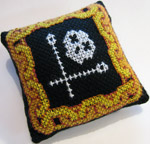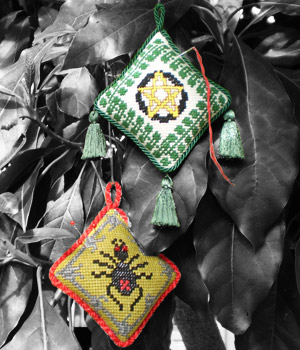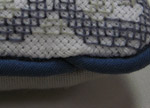

 |
 |
 |
 |
 |
 |
 |
 |
pillow talk > malice > sick fuck
The Elizabethans and their cousins, the Stuarts, were fond of complicated tent-stitched cushions and wall hangings that included birds, moths, parrots, apples, people on horseback, hawks, dogs, strawberries, peapods, and seemingly whatever else entered their heads.
Chris Laning designed a simple pincushion inspired by this style of needlepoint for her reenactment Needleworkers Guild. The leafy border pattern is lifted directly from an English sampler made in the early 1600s. Any small motif may be stitched in the center, including hearts (sigh!) and roses (oh, how sweet!)
But The AntiCraft is made of sterner stuff, so Chris has repurposed her pincushions with new designs using spiders, cats, and snakes. Then, of course, we had to join in and add rude hand gestures, Space Invaders, and (for the secretly sentimental—we know you're out there) a number of designs inspired by nature and the cosmos, in case you suck up to worship them. We've also designed new borders of chain and barbed wire. How's that for a project a few hundred years in the making?
(P.S. To be fair, the Elizabethans were also fond of adding snails, caterpillars, and flies in among the blooming plants of their embroideries. So they were not total wimps.)
Suggested Listening
The Art of the Bawdy Song by The Baltimore Consort and The Merry Companions
Difficulty
All Tied Up At the Moment
Click here for definitions of difficulty levels.
Finished Measurements
Approximately 5"/12.7cm square, plus hanging loop.
Download
The Sticking Place motif and border charts (PDF format)
Materials
- 11 count Aida cloth
- Scrap fabric or masking tape
- Embroidery floss in your choice of colors
- Tapestry needle
- Needle threader (optional)
- 14" wide stitching frame or 8"embroidery hoop
- Beads and/or charms (optional)
- Fabric remnant in a complementary pattern or color
- Fiberfill
- .25"/6mm decorative cord
- Sewing thread to match cord
- 1-3 Tassels (optional)
Design Notes
The examples shown here were stitched with several different brands of embroidery floss. Go with your gut when it comes to color, but try not to use different brands of floss in the same project, as they may give different amounts of coverage. When using two shades of the same color in a single motif (as in the barbed wire border) choose shades that contrast much more than you think necessary. Otherwise the detail will be very hard to see in the finished stitchery.
You can, of course, stitch on whatever size canvas you like, but different canvas sizes will give different finished measurements. For 11 count Aida, you'll need about a half yard of decorative cord. You may need two skeins of whatever color floss you use for the background of your needlepoint design, and perhaps for the leafy border, as well.

A cross stitched version
Sarah Hood (embroidery)
Raellyn Hatter (finishing and photo)
click image to enlarge
The directions given here are for tent stitch. You can also do cross stitch, but you'll probably want to use fewer strands of floss, maybe three, in that case.
Learn from Carin's mistakes: If you are stitching more than one pincushion at a time, and are using a scroll type stitching frame, don't give in to the temptation to stitch both designs on a single piece of aida cloth. Rolling the first stitched pincushion front onto the scroll rod distorts the fabric where you're going to stitch the second pincushion, making it difficult to get even tension and straight lines of stitching.
If you want to add tassels to your pin cushion, but can't find any that match your materials, consider making your own, as explained in What Are You Looking At? Keep in mind that your tassels will be half as long as the width of your cardboard strip. (A 3"/7.5cm wide strip will yield tassels 1.5"/3.8cm long.) Use the same floss with which you stitched the front of your pin cushion, or find a color of DMC's Satin floss (100% rayon, 8m/8.7 yds per skein) to match your decorative cord. (The tassels on the the pentacle pin cushion were made with DMC Satin, color S501.) One skein of this will produce two 1.5"/3.8cm tassels. An extra pair of hands may help get knots tied in the slippery rayon, and a spot of glue will encourage the knots to stay tied.
Don't know how to do a certain stitch? Check out the Glossary of Techniques.
Need help choosing a needle? Read this guide.
Last, but not least, you can check out Chris' West Kingdom Needleworkers Guild or the orignal project instructions online.
Stitch the Design:
Pick a border design and a center design, or choose one of the allover designs. Bind the edges of the aida cloth, mount it in the stitching frame or hoop, and thread a tapestry needle with 6 strands of floss which have been separated from each other, then laid back together, to increase the coverage of the stitches. Embroider your chosen design using the tent stitch (aka continental stitch). One square on the chart equals one stitch. When you have filled in the entire pattern, including the background, with tent stitch, outline any areas you wish to with two strands of floss using a backstitch. Remove the stitched aida cloth from the frame or hoop, block and press it. Sew on any beads or charms you like. Cut the excess fabric off, leaving 1/2" of unstitched cloth on every side.
Make the Cushion:
Cut a piece of backing fabric the same size as your cut out stitchery. Press 1/2" under on both the fabric and the aida cloth, and stack them, wrong sides together. With two strands of your background color floss and a hand sewing needle, sew the folded edges together using an overcast stitch. Start sewing at the top corner, sew around three and a half sides. Leave two to three inches unsewn, but don't tie off or cut the sewing floss. Just leave the needle hanging while you stuff the cushion firmly with fiberfill. When the cushion is stuffed, continue sewing the opening closed to within a half inch of the top. Knot the thread, then stick the needle into the seam at the knot, bringing it out of the cushion a few inches away at some random place. Tug the floss firmly, cut it close to where it exits the cushion, and let the end slip back inside.
Add the Decorative Cord:
Lay the decorative cord along the side that you just sewed up, with the end of the cord sticking just past the top corner of the cushion, over the small opening you left in the seam. Thread the hand sewing needle with the sewing thread, knot it, and bring the needle up from insided the seam where you made the last closing stitch. Run the needle through a bit of the cord, then put it back down into the cushion at the same spot. Bring the needle out about .25"/6mm further along the seam, working away from the top corner, go through the cord, and back down in the same spot. Continue in this way all the way around the cushion, making sure to put a stitch directly at each corner as you go.
When you get back to the top corner of the cushion, form a small loop with the cord, with the end coming down in the back. Tuck both ends of the cord into the small opening you left in the seam (a pair of tweezers may help with this), doing your best to bring the cord near the first end flush to the loop. Stitch all the cords to each other as neatly as you can, and stitch the opening in the seam closed to or through the cords as well. Knot the thread and hide the end inside the cushion as before.
Optional Finishing:
If you like, sew tassels to the side and/or bottom corners, attaching them behind the cord. If you have made your own tassels, thread the ends of the top tie on the tassel into a needle and use them as the attaching thread. Knot and hide the ends of the thread as before.
If a 16th century playwright comes whining to you about modern man's lack of courage, show him where he can screw it.
About
 contact Chris:
•
contact Carin:
• legal info
contact Chris:
•
contact Carin:
• legal info
![]()
home • antifesto • this issue • archive • submit • errata • masthead • contact us • legal

